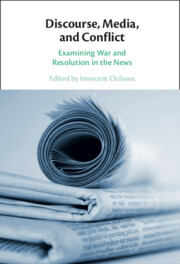Book contents
- Discourse, Media, and Conflict
- Discourse, Media, and Conflict
- Copyright page
- Contents
- Figures
- Tables
- About the Authors
- Foreword
- Introduction
- Part I Conflict Discourse in Newspaper Reporting
- Part II Electronic Media and Online Discourses of Conflict
- Part III Media Discourse and Conflict Resolution
- 10 The Language of Peace in Conflict Transformation
- 11 The Historical Context in Media Narratives in Search of Peaceful Resolution to the Israel–Palestine Conflict
- 12 From Peace Talks to Military Operation
- 13 From Collision to Diplomatic Compromise
- 14 Constructing Identities in Crisis Situations
- Conclusion
- Index
- References
10 - The Language of Peace in Conflict Transformation
A Critical Analysis of the New York Times’ Coverage of the Israeli–Palestinian Peace Agreement and Its Role in the Discursive Context of the Oslo Negotiations
from Part III - Media Discourse and Conflict Resolution
Published online by Cambridge University Press: 21 April 2022
- Discourse, Media, and Conflict
- Discourse, Media, and Conflict
- Copyright page
- Contents
- Figures
- Tables
- About the Authors
- Foreword
- Introduction
- Part I Conflict Discourse in Newspaper Reporting
- Part II Electronic Media and Online Discourses of Conflict
- Part III Media Discourse and Conflict Resolution
- 10 The Language of Peace in Conflict Transformation
- 11 The Historical Context in Media Narratives in Search of Peaceful Resolution to the Israel–Palestine Conflict
- 12 From Peace Talks to Military Operation
- 13 From Collision to Diplomatic Compromise
- 14 Constructing Identities in Crisis Situations
- Conclusion
- Index
- References
Summary
This chapter examines the relation between language and conflict resolution, by focusing on the beginning of the Israeli–Palestinian peace process in 1993 as it was represented by the New York Times. It analyzes the front-page articles dedicated to this dialogue and discusses the results in the context of the diplomatic negotiations and the political and social discourses of peace available at the time. The chapter also shows how the diplomatic discourse concealed opposite views of the peace process, and it maps the transfer of dominant discourses of peace from the political and social levels to the media and diplomatic ones. Finally, it discusses the implications of such dynamics for peace achievement.
- Type
- Chapter
- Information
- Discourse, Media, and ConflictExamining War and Resolution in the News, pp. 235 - 256Publisher: Cambridge University PressPrint publication year: 2022

